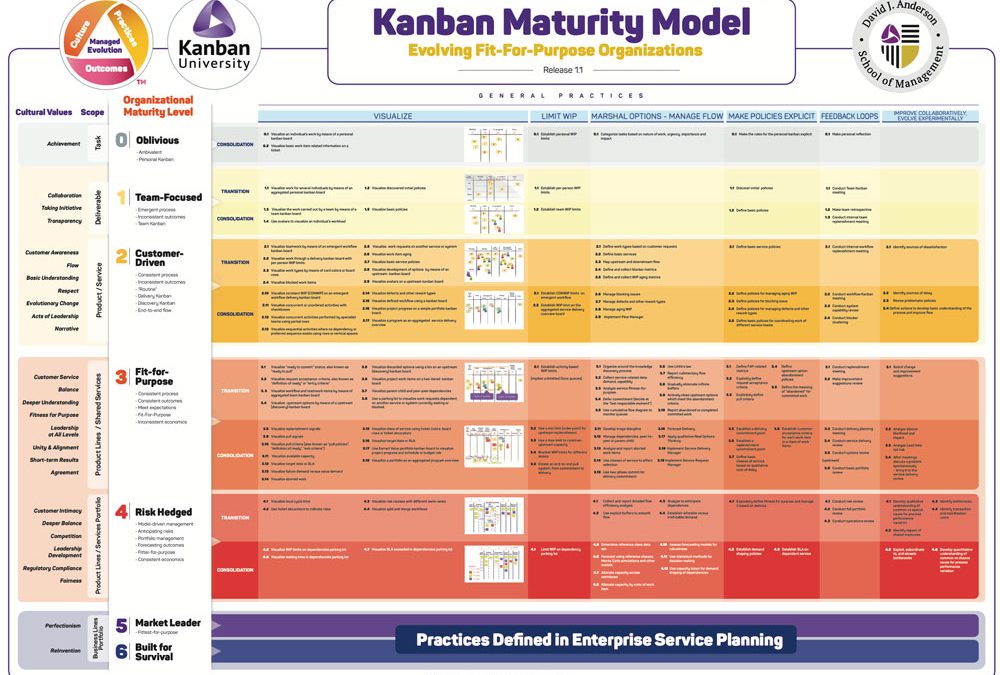To read in Spanish, click here.
Since the publishing the beta release of the Kanban Maturity Model a year and a half ago, a number of Kanban Coaching Professionals have used it in different organizations and business fields. Susanne Bartel, Steve McGee, Minton Brooks, Brad Hughes, Frank Vega, Ivaylo Gueorguiev, Kaveh Kalantar, Amit Kaulagekar, Pavel Klimenko, Ivan Font and I 😊 are some of them.
David J. Anderson and I are actively teaching the model to Kanban Management Professionals and coaches working to develop further the business agility of their clients.
All this experience and feedback has allowed us to understand better what challenges organizations face on the path towards their purpose and how Kanban practices and values help them overcome the drawbacks. Release 1.1 of the visual materials and the upcoming book include the additional knowledge we have gained and codified so that organizational change agents can take advantage of it.
More precisely, these are the updates which you will find:

- Better descriptions of the maturity levels (ML) showing how organizations evolve developing their fitness-for-purpose. More precisely, how they improve in the following aspects:
- new habits and cultural values
- deeper Kanban management practices
- relief from overburdening
- coherent decision making al all levels, taking into account tactical, operational and strategic concerns
- consistent and efficient work process
- alignment and unity around a shared purpose
- better business outcomes
- capabilities to anticipate and address changes in the business environment
- Updated list of cultural values: currently KMM defines 34 values vs 20 in the beta release. All these facilitate the adoption of the Kanban thinking at all levels of an organization and the successful leadership of cultural change initiatives.
- Introducing the Flow Manager role at ML2 – focused mainly on understanding demand and capacity and reducing delays by means of analysing the blocker and rework causes and implementing appropriate improvement actions. This role evolves to Service Delivery Manager at ML3.
- Introducing the Service Delivery Manager role at ML3 managing the flow of committed work downstream ensuring sustainable delivery of fit-for-purpose services.
- Introducing the Service Request Manager role at ML3 managing the flow of options upstream.
- Additional Specific Practices and improved practice description. Release 1.1 contains 150+ practices compared to 132 in the beta release. They all include description of the intent of the practice and more detailed guidance on how to implement it.
How can you use the updated visual materials?
- The A3 poster summarizes what benefits organizations get from KMM and how culture and practices scale across the maturity levels. Use it to explain what the model brings to an organization in terms of culture, practices and business outcomes, facilitate the definition of appropriates objectives, and involve the right management people.
- The A0 poster lists the titles of the practices and values per ML. Use them to identify appropriate practices that can address the needs of your organization.
- Use both posters to find out where your organization is and develop a roadmap for evolving it further avoiding known barriers or overreaching.
How to get started with KMM?
- Download release 1.1 of the materials from the KMM web site
- Visit the KU web site and register for the KMM and Kanban Coaching Practices courses to take advantage of this codified knowledge and experience
- Read the upcoming book
- Contact us, if you have questions
Related Arcticles:
- What Executive Managers Need To Know About The Kanban Maturity Model and Business Agility
- Process Improvement, Kanban and KMM
Teodora Bozheva
Co-author of the Kanban Maturity Model
www.berriprocess.com


Looking forward to the new book. The KMM is the best tool in a coach’s kit. Its not overwhelming but still creates the urge to learn and evolve. Thank you!
Thank you Aparna.
You will get all updates about the model through this page.
If you need additional information, let us know.
Awesome!
Will it be always the case a need to buy new KMM book after each release?
Thanks!
Yehor,
The 2018 edition of the book is the beta realease of the model.
The next book is going to inlcude the complete content of release 1.1 of the model. It is a prety stable content already, validated in a number of companies in different business sectors. Therefore, I believe it will stay unchanged for quite some time, and be useful for all the companies who want to become fit-for-purpose.
Teodora
Love the new content.
Any idea on when the book launch is scheduled for?
Good luck with promotion!
Devin,
I am glad you like the content.
Our intent is to publish the new book around May-June 2020.
You will find lots of new content in it.
Hello Teodora!
Tell me please, why in KMM used the order from up to down (the 0 levels in the top, the 6 levels in down)?
If we look at CMMI then we will see reverse order.
Hello Pavel,
The top-down order of the levels visualizes the dept of the organizational change which the KMM practices and values enable.
It is typical to start from team level, which is ML1: Team-focused.
ML2: Customer-Driven is about connecting several tams in an end-to-end workflow delivering a complete service to customers.
ML3 Fit-for-Purpose and ML4 Risk-Hedged are about aligning the entire organization around a shared purpose and ensuring a continual delivery of services that satisfy customer expectations in a sustainable manner.
ML5 Market Leader and ML6 Build for Survival are focused on optimizing for market leadership, anticipating the future, reinventing the business and ensuring long-term survival.
Hello, Teodora.
I’ve bought the book this year. Are you planning to send us a new version of the book or do we need to buy a new version to have the most updated version?
Regards,
Marcelo
Hi Marcelo,
Unfortunately, we will not be able to send the new book to all the people who bought the previous one. I am sorry.